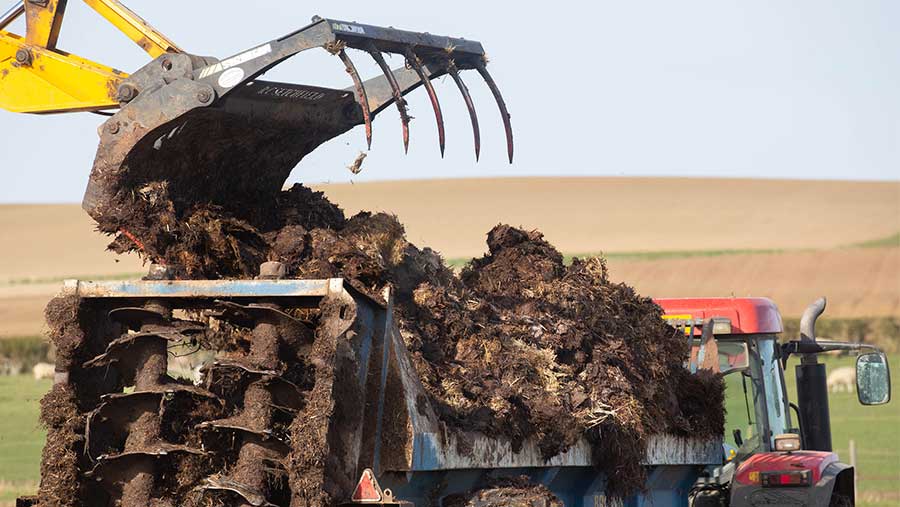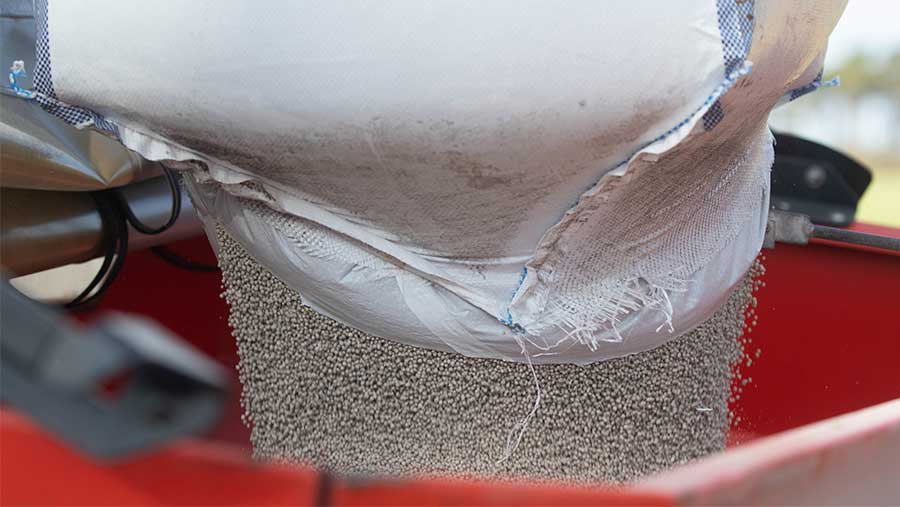The rules for arable farming in an NVZ in Northern Ireland and Scotland

© Tim Scrivener
Nitrate vulnerable zones exist to protect the environment against potential pollution from fertiliser and manure applications.
Each devolved nation has its own rules – so what do arable farmers need to do to comply in Scotland and Northern Ireland (NI)?
What’s it all about?
The rules stem from the EU Commission’s Nitrates Directive, which aims to protect water quality across Europe through promoting best farming practices to prevent nutrient leaching.
See also: The rules for arable farming in an NVZ in England
Where nitrates in water exceed – or are likely to exceed – the maximum levels set, the areas are designated as nitrate vulnerable zones (NVZs) and nations must enforce an action programme.
This regulates how manures and fertilisers are stored and used on farm, including minimum storage requirements, closed periods for application and a maximum level of nutrient application per crop and farm.
Although the devolved governments could, in theory, revoke NVZ rules following the UK’s departure from the EU, this is unlikely to happen.
Each nation remains committed to reducing water pollution and legislation is only likely to increase in the years ahead.
Which areas are affected?
In Northern Ireland, all agricultural land must comply with the Nutrients Action Programme (NAP) – NI’s version of NVZs.
In Scotland, NVZ designations are reviewed every four years. There are currently five NVZs in Scotland:
- Lower Nithsdale
- Lothian and Borders
- Strathmore and Fife (including Finavon)
- Moray, Aberdeenshire/Banff and Buchan
- Stranraer Lowlands
Farms which fall partially within an NVZ need only comply with the measures on designated fields.
What are the minimum storage requirements for manures?
The minimum storage capacity is required to cope with closed spreading periods and must take account of local conditions. It is:
- 26 weeks for pig slurry and poultry manure
- 22 weeks for cattle or other livestock slurries
Farmers must take into account any rainfall or washings which enter the store.
Solid manure – which can be stacked in a freestanding heap without slumping and does not produce free drainage of liquid – can be stored in temporary field heaps.
These must not remain in place for longer than 12 months (120 days in NI), and cannot be located within 10m of surface water (20m in NI) or 50m or a well, borehole or other water supply (50m of lakes in NI).
Field heaps cannot be located in high-risk areas and must be identified on the risk assessment map.
Solid manure volumes do not count towards minimum storage capacities. Manure which does not meet the definition of solid manure must be stored on an impermeable base and the run-off collected. Any permanent storage sites must be covered.
What are the closed application periods?
These vary according to region, cropping and soil type, but range from 1 September to 20 February for chemical nitrogen fertiliser applications in Scotland (15 September to 31 January in NI, which also encompasses phosphorus applications).
In Scotland, organic manure with high available nitrogen content (such as slurry, poultry manure and liquid digestate) must not be applied to grassland between 1 September and 31 January, depending on soil type.
On cropped land, the closed period for these slurries ranges from 1 August to 31 January, depending on soil type.
There are further restrictions relating to applications either side of the closed period and on bare or stubble ground.
In NI, the closed period for high N organic manures, regardless of cropping or soil type, is 15 October to 31 January.
How much nitrogen can I apply?
Loading limit for livestock manure: 170kg N/ha/year across the whole farm, including imported manure and excretions from animals.
Field application limit for organic nitrogen: 250kg N/ha/year from all organic manures, excluding compost, grazing deposition and chemical fertiliser.
Field manure and compost limit: 500kg N/ha over 24 months, including all organic manures but excluding grazing deposition and chemical fertiliser.
What about phosphates?
In NI, organic manure containing more than 0.25kg of phosphorus per 1kg of total nitrogen can only be applied where there is a crop requirement. A phosphate fertiliser plan must be produced each year, including soil nutrient status.
Is there a derogation to the 170kg/ha limit?
Farms with an agricultural area that is 80% or more grassland can apply annually to increase the limit to 250kg/ha of nitrogen from grazing livestock, subject to certain conditions.
What is N-max?
N-max is the maximum nitrogen which can be applied to each crop (including grassland) and includes both chemical and organic sources.
The total nitrogen available to the crop must not exceed the N-max calculation. Compliance with N-max is assessed across the crop types on the farm, not at individual field level.
The standard nitrogen requirement will be based on previous cropping and soil type, and can be adjusted to take account of rainfall and above-average yields.
Careful planning will allow you to match nitrogen application with crop need.

© Tim Scrivener
What are the fertiliser/manure application rules?
Nitrogen fertiliser must not be applied when land is waterlogged, frozen or snow covered.
Soil conditions, type and slope must also be considered, with no application made within 2m of a surface water body or where the fertiliser is likely to enter any watercourse.
Organic manures must not be spread within 10m of surface water (20m in NI) or 50m of a well, borehole or similar.
You must leave three weeks between each application and there are restrictions on the maximum applied.
Slurry must not be applied using a high trajectory splash plate (except where growing arable crops in Scotland).
What planning is required?
Every year, before 1 March, you must prepare and implement a fertiliser and manure management plan. This must contain:
- A risk assessment plan and map if you apply organic manures
- A calculation and record of the storage capacity required for manure/slurry
- A calculation and record of 170kg/ha loading limit for livestock manure
- An N-max calculation for each crop type grown, including grassland.
Online tools are available to help with these calculations.
What records must I keep?
Annual records must contain the area of the farm within an NVZ/NAP, the area of each designated field, its soil type, crops grown, and date of sowing.
You must also record the date, quantity and type of chemical fertiliser and organic manure applied to each crop.
Livestock records include the species and type of livestock, length of time kept on the farm, and details of any movement of livestock manure on or off the farm – including its nitrogen content, based on standard figures or analysis.
You must also keep an inventory of the chemical fertiliser purchased, used and retained on farm.
Records must be kept for three years following 31 December of the period to which they relate (five years in NI).
What happens if I don’t comply?
Non-compliance will usually result in a notice explaining required action to be taken within a specified timeframe. NVZ and NAP regulations form part of cross-compliance for the Basic Payment Scheme and other direct payments.
Failure to comply may, therefore, result in a financial penalty under these schemes, as well as possible criminal prosecution for environmental pollution.

